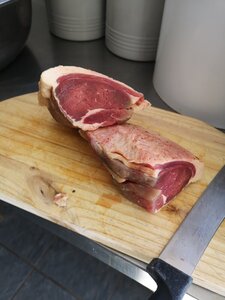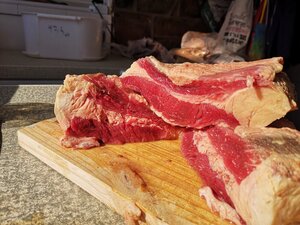I've done quite some research about the perfect cure/brine. I made one three years ago and have been refining it until recently when my last batch came out perfectly. You can use this recipe for anything you want to cure. I've made eisbeins, brisket, pork chops, ham, sandwich meat and even game/venison with it.
Ingredients:
1kg salt
40g saltpetre
3 tablespoons pickling spice
10g bicarbonate of soda
30ml brown grape/wine vinegar
190ml brown/trickle sugar
2 teaspoons paprika
2 teaspoons crushed blackpepper
2 teaspoons broken/crushed mustard seeds
12 liter water (10 liter if you prefer a more salty brine)
Method:
1. Take a big pot and put about 2 liter water in and bring it to almost a boil on the stove.
2. Add all the dry ingredients to the water.
3. Boil until everything have dissolved and the spices cooked well into the water.
4. Add the vinegar. But be careful, the vinegar/bicarbonate of soda reaction may cause your water to boil over, so add it slowly.
5. In your curing bucket/holder add the rest of your water. Make it as cold as possible by adding some ice to the water.
6. Now add the water in the pot to the cold water in your bucket.
7. For this recipe you can at least cure about 12-15kg of meat. When the water is cold enough, add your meat. Inject the bigger pieces of meat with the brine as needed.
8. Leave the meat for 5-7 days in the brine, depending on how salty you want it.
If you have less than 10kg of meat, use the same recipe, but just take you meat out earlier.
Attached is a picture of the briskets and beed hump that I made recently.
Ingredients:
1kg salt
40g saltpetre
3 tablespoons pickling spice
10g bicarbonate of soda
30ml brown grape/wine vinegar
190ml brown/trickle sugar
2 teaspoons paprika
2 teaspoons crushed blackpepper
2 teaspoons broken/crushed mustard seeds
12 liter water (10 liter if you prefer a more salty brine)
Method:
1. Take a big pot and put about 2 liter water in and bring it to almost a boil on the stove.
2. Add all the dry ingredients to the water.
3. Boil until everything have dissolved and the spices cooked well into the water.
4. Add the vinegar. But be careful, the vinegar/bicarbonate of soda reaction may cause your water to boil over, so add it slowly.
5. In your curing bucket/holder add the rest of your water. Make it as cold as possible by adding some ice to the water.
6. Now add the water in the pot to the cold water in your bucket.
7. For this recipe you can at least cure about 12-15kg of meat. When the water is cold enough, add your meat. Inject the bigger pieces of meat with the brine as needed.
8. Leave the meat for 5-7 days in the brine, depending on how salty you want it.
If you have less than 10kg of meat, use the same recipe, but just take you meat out earlier.
Attached is a picture of the briskets and beed hump that I made recently.







